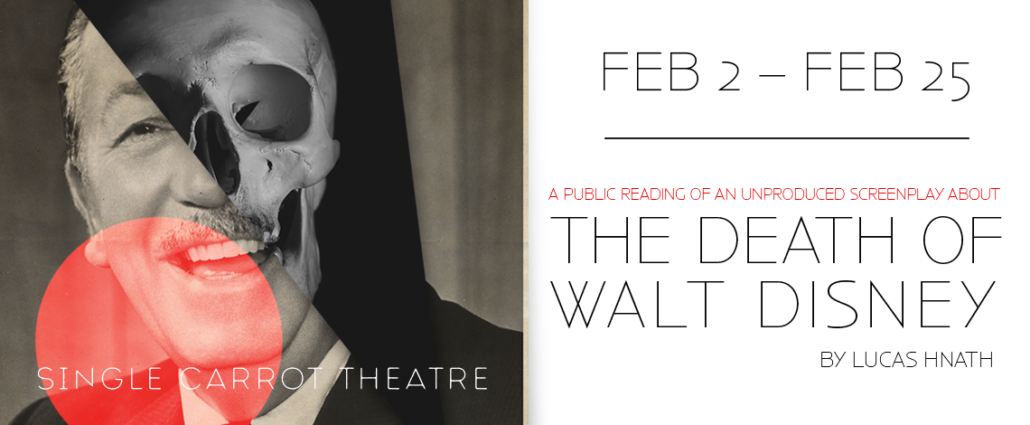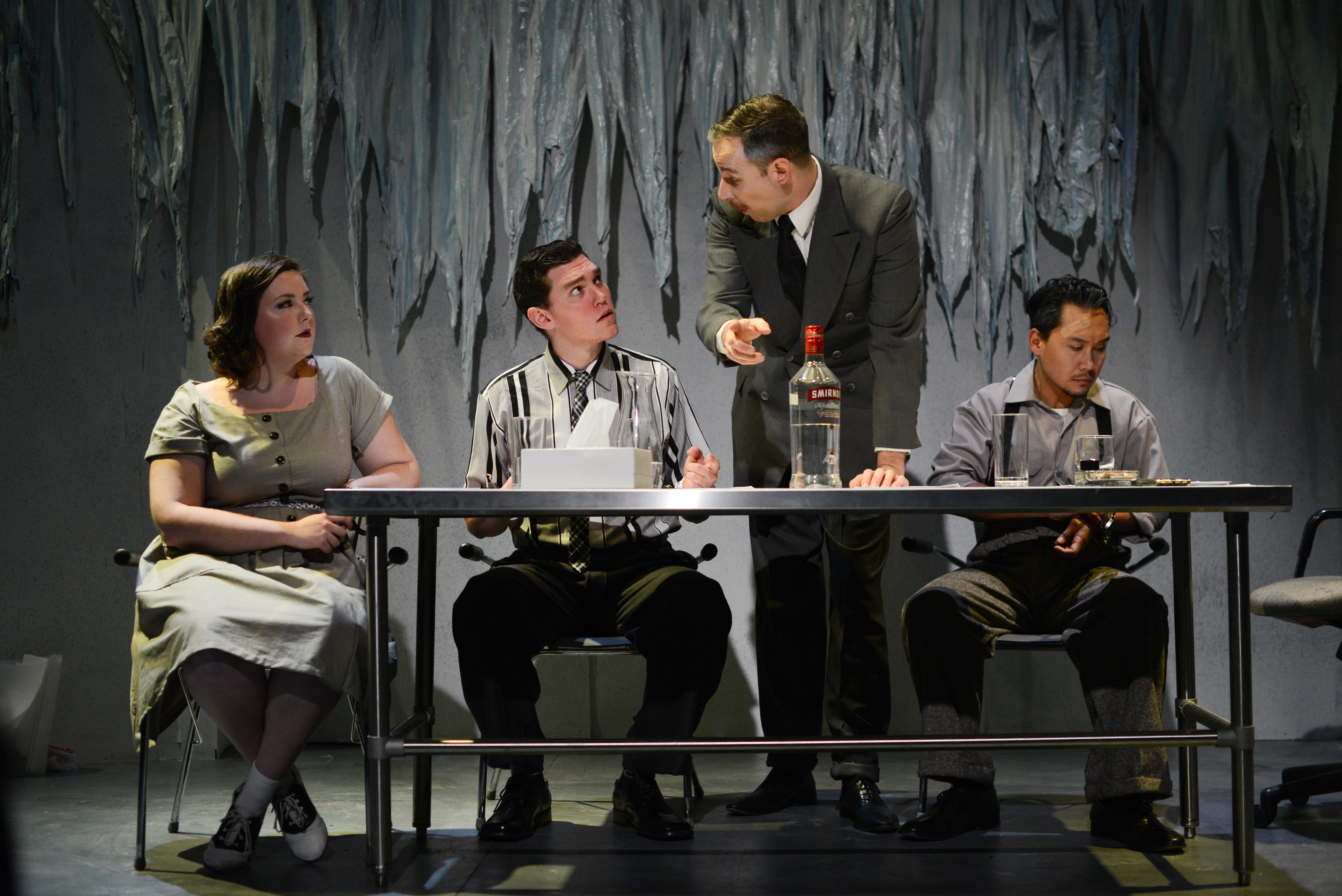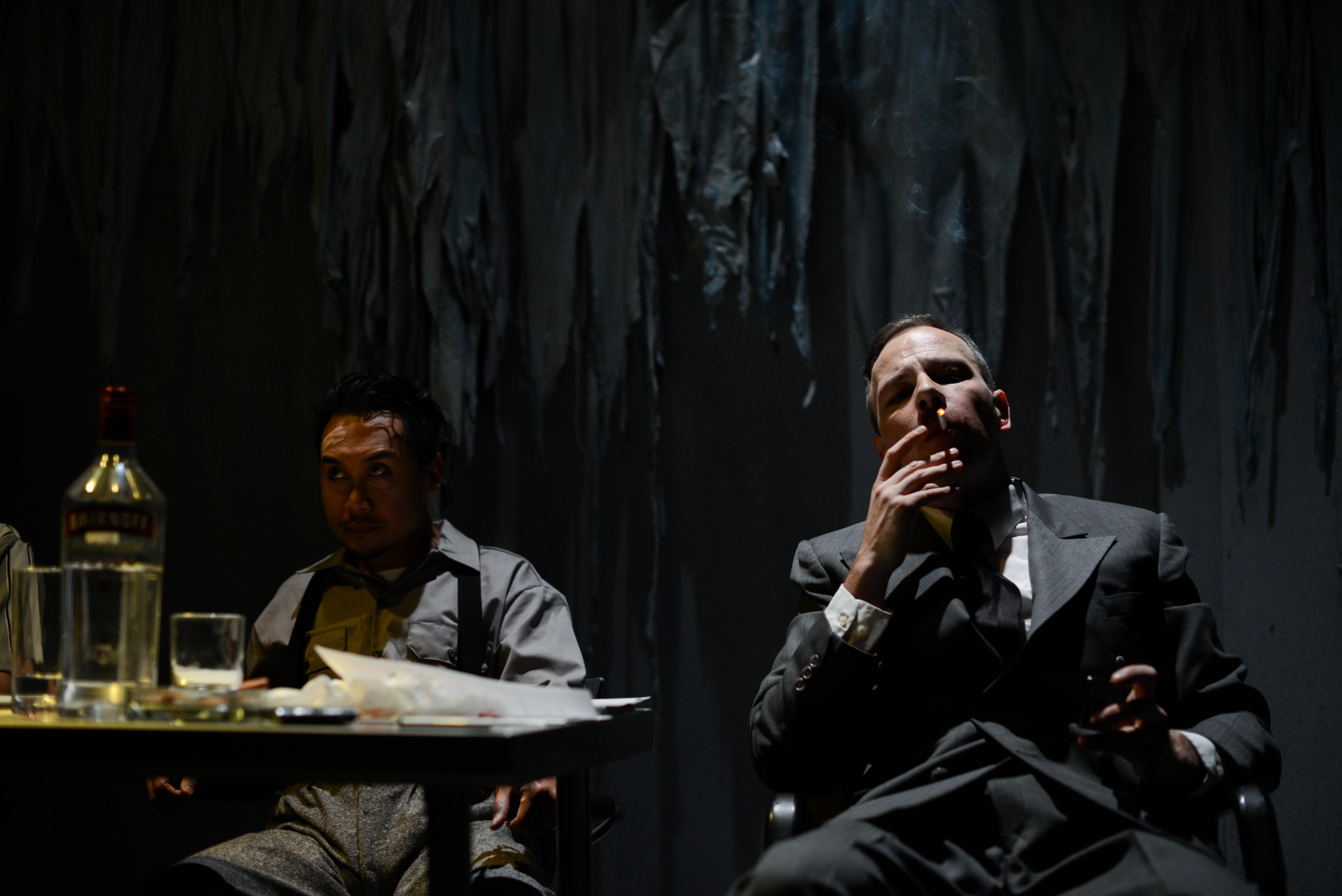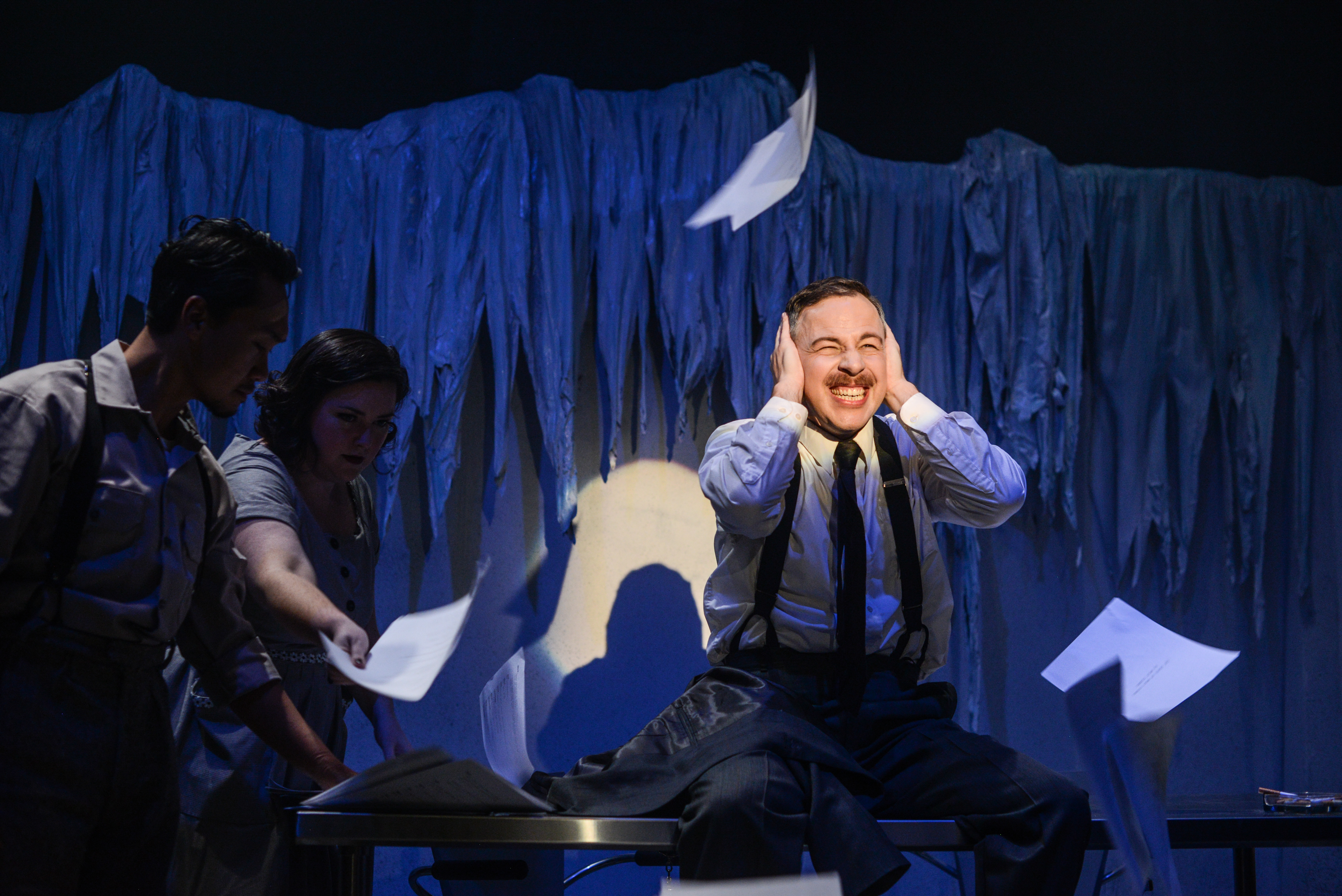By Jason Crawford Samios-Uy

Running Time: Approx. 90 minutes with no intermission
Walt Disney. Chances are, you know who he is and, more importantly, what he’s done. There’s no denying the man was uber-successful in business and “the happiest place on earth” came from the depths of his mind. However, for all the joy and happiness he brought to millions upon millions of people of all ages, even until this day, there was, of course, a darker side to this captain of industry. In Single Carrot Theatre’s latest offering, A Public Reading of an Unproduced Screenplay About The Death of Walt Disney by Lucas Hnath, Directed by Genevieve De Mahy and Matthew Shea, they shed light on the more unsavory characteristics of the this “Uncle Walt” and gives a glimpse into behind the scenes of some of his best and brightest ideas.

(l-r) Meghan Stanton, Eric Poch, Paul Diem, Mohammad R. Suaidi. Credit: Britt Olsen-Ecker
Don’t let the title fool you. This piece is not just a reading but a play about a reading of an unproduced screenplay. Actually, it’s kind of clever. The screenplay being read is supposedly one written by Walt Disney himself, about himself, and includes background information during various points of interest in his life that the public may not have been privy to. If its point was to make Walt Disney look like a completely self-centered asshole who did what he needed to see out his visions and dreams, no matter what it was he had to do or say or who he had to hurt, this piece was totally successful. My question is… why?
I’m not a total fanatic when it comes to Disney. I enjoy the films, the music, the theme parks, all that… but I’m not going out of my way for them. However, with that being said, I’m curious as to why this piece was written. Was it simply to mar a man’s name? To shatter an image? To break the magic his name has brought to the aforementioned millions upon millions of people who live and breathe anything Disney and soak up it creates? If so, why? What’s the point? What’s more, the man isn’t even around to defend himself. Why try to destroy the legacy of man who has brought happiness to the world? One argument could be because bringing that happiness brought pain and strife to others. I don’t deny that. It probably did, or so says Lucas Hnath in this script. But, please, show me a man as successful as Disney who built an empire being the nice guy all the time. Is it right? I won’t tell you what’s right or wrong, that’s for you to decide for yourself, but is it a necessary evil when trying to attain the success Disney wanted? Yes. The material in this piece seems one sided and bitter and doesn’t seem to tell the story for enlightenment, but, for reasons only known to the author, for spite and “sticking it to the man,” as it were. That’s how I see it, anyway.

Mohammad R. Suaidi, Paul Diem. Credit: Britt Olsen-Ecker
But I digress… I’ll step off my soapbox and get into the production itself, which is actually a very well-put together production. I could have done without the production of getting from the lobby to my seat, going through a dark, tight corridor with LED icicles that, I assume, is supposed to represent some kind of theme park or carnival attraction, then the clog at the performance space entrance because we had to stop to be seated personally by “Mr. Disney” with this Cheshire cat smile. When it’s general seating, I like to get from the lobby to my seat (which I like to choose) as quickly and efficiently as possible.
One major problem with this piece is the script. I am actually a fan of Lucas Hnath and it pains me to say, but this script is nothing but a jumble with incomplete sentences and cut offs. It’s hard to follow along and it continues through the ENTIRE piece. Luckily, this production of chock full of an able cast because the script is pretentious and trite being more show than substance.

Mohammad r. Suaidi, Meghan Stanton, Paul Diem. Credit: Britt Olsen-Ecker
The space, however, is set up beautifully and that’s one of the things I really like about Single Carrot Theatre – their ability to change their space to fit the needs of the production. The tiered seating worked nicely for this production and the minimal Scenic Design by Kristin Hessenauer, Hayden Muller, Allison Blocechl, Cydney Cohn, and Sierra Ho is appropriate and effect, but I’m not sure why so many hands were involved in such a minimal Scenic Design… unless they are counting the seating arrangement and creepy entrance corridor, then maybe, but the simple cramped conference room setting is fitting and helps set the mood of this production.
Lighting Design by Helen Garcia-Alton and Sound Design by Glenn Ricci are impeccable and really help move this piece along. The changes from dim to full light are flawless and set the time and mood for each scene bringing the action together seamlessly. Garcia-Alton manages to capture the two sides of Walt Disney with both subtle and drastic changes in the lighting and keeps the audience engaged. Playing in tandem with the Lighting Design, Ricci’s Sound Design is careful not to overwhelm the production but blends in with the action to help tell the story and keep the action interesting.

(l-r) Meghan Stanton, Eric Poch, Paul Diem, Mohammad R. Suaidi. Credit: Britt Olsen-Ecker
Co-Directors Genevieve De Mahy and Matthew Shea have a good grasp of this material and seem to like the purpose of exposing the dark side of Disney and stripping away prestige of the name. The minimal staging is wise and the action is stellar. The fact that all characters, except for Walt Disney are handcuffed to the table as if being kept prisoner and forced to listen, is powerful and drives home the kind of person Walt Disney was in real life. Their casting is top notch and they convened a cast with great chemistry and talent to pull this material off. Overall, their vision and presentation are on point and they should be applauded for their efforts in bringing this challenging script to life.
Eric Poch takes on the role of Ron Miller, Disney’s son-in-law, who is a fan, or so it seems, and needs a job. Poch seems to really embody this character with a goofy smile and tone that fits the character nicely (a former pro football player). He plays the character as an oafish but lovable guy and makes a good showing working well with and off of his cast mates.

(l-r) Meghan Stanton, Eric Poch, Paul Diem. Credit: Britt Olsen-Ecker
Mohammad R. Suaidi tackles the role of the level headed and loyal lesser known brother, Roy Disney. Suaidi seems to have a good grasp on this character and seems comfortable in the role. His chemistry with Paul Diem (Walt Disney) is terrific and they work well with each other. This character could easily be played as a doormat for the title character to walk over, but Suaidi finds a good balance of loyalty and standing his ground in this character that plays quite well.
Meghan Stanton as Daughter (assuming it’s Diane Disney, since Ron is her husband) is a definite highlight of this production. She doesn’t have much to say but every line she delivers is genuine and her confidence and presence is strong, which works well with this discontented character. Stanton emotes the conflicting emotions of this character such as her love and hatred for her less-than-saintly father and her worry for her children is clear making for an overall outstanding performance.

Paul Diem as Walt Disney. Credit: Britt Olsen-Ecker
Paul Diem shines as he takes on the titular role of Walt Disney. From the moment he enters the lobby to direct the audience to the performance space, Diem embodies Disney head to toe, which is no small feat. Though the structure of this script is horrendous, he does a brilliant job with his delivery, not skipping a beat in the fast-paced jumble of words. Not only is his delivery good, he really seems to have a good understanding of the character and man his he portraying.
Final thought… A Public Reading of an Unproduced Screenplay About The Death of Walt Disney at Single Carrot Theatre is an interesting take on the beloved Walt Disney and sheds light on a darker side of the man who brought the world so much happiness. I hesitantly write this, but… this was not my kind of show. Now, let me be clear that the performances were pretty much spot on and the ensemble presented the material superbly with focused and engaging staging, but the script is trite and garbled with all of the “cut to” and broken sentences making it difficult to understand (and utter agony for anyone with an English degree). I’m actually a fan of Lucas Hnath and thoroughly enjoyed another piece producer last year in Baltimore, The Christians, so I know he can write, but this one seems to be trying too hard. However, don’t take my word for it. Go see it and form your own opinion, it just might be your kind of show.
This is what I thought of Single Carrot Theatre’s production of A Public Reading of an Unproduced Screenplay About The Death of Walt Disney… What did you think? Please feel free to leave a comment!
A Public Reading of an Unproduced Screenplay About The Death of Walt Disney will play through February 25 at Single Carrot Theatre, 2600 North Howard Street, Baltimore, MD. For tickets, call the box office at 443-844-9253 or you can purchase them online.
Email us at backstagebaltimore@gmail.com
Like Backstage Baltimore on Facebook
Twitter @BackstageBmore
Instagram @backstagebaltimore
Follow Backstage Baltimore on Twitte(backstagebaltimore)

